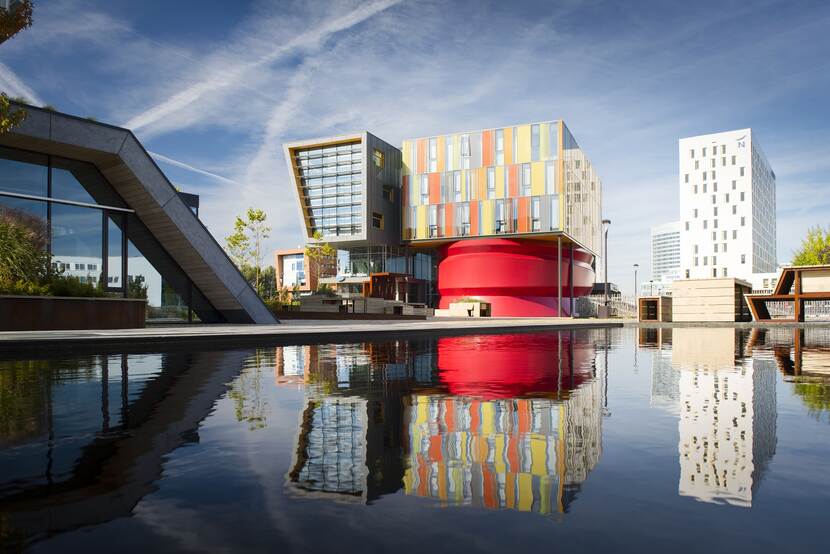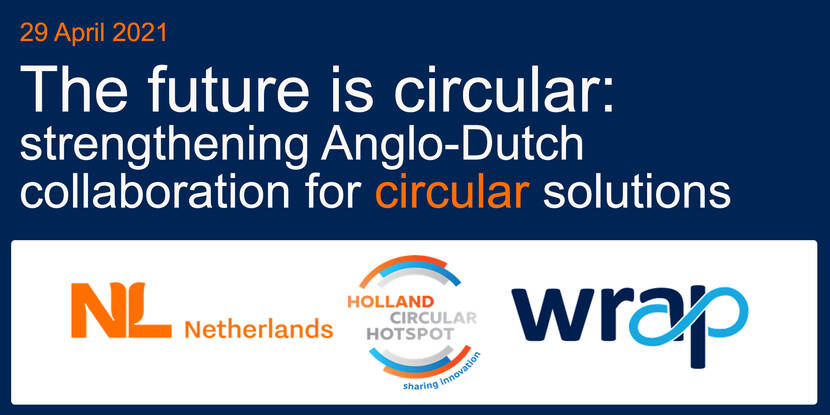The Netherlands and UK have much to learn from each other – and to inspire each other with – in the developments and innovations for circular solutions in plastics, textiles & fashion, and the built environment.v The Dutch Embassy in the United Kingdom, WRAP UK and Holland Circular Hotspot hosted “The Future is Circular: Strengthening Anglo-Dutch Collaboration in Circular Solutions”, an exchange of ideas focused on the opportunities and challenges in the transition towards a more circular economy. Expert speakers discussed efforts to present circular business models, share best practices and illustrate circular actions from various perspectives.

Karel van Oosterom, Dutch Ambassador to the UK, opened the event by highlighting the importance of collaboration in the transition to a circular economy. While challenges remain due to Covid-19 and Brexit, the Ambassador emphasised the role collaboration plays in the faster development of circular innovations, creating economies of scale and driving incentives for investment.
Opportunities and challenges in Circular Economy
Inspiring case studies in Plastics, Textiles and the Built Environment from both sides of the North Sea offered opportunities for continued sharing of best practices and knowledge exchange. The main challenge to accelerating the transition to a circular economy is scaling up circular business models. Collaboration – at all levels – is necessary to ensure governments, businesses, and other organisations can complement and strengthen each other in the transition.

Plastics
WRAP shared lessons from The UK Plastics Pact. Members of the UK Plastics Pact represent over 85% of plastic packaging on products sold in UK supermarkets; bringing together stakeholders from across the entire plastics value chain creates a robust recycling system in the UK. Targets are set to eliminate unnecessary plastic packaging and ensure effective re-use and recycling: to keep it in the economy and out of the environment. WRAP stressed the importance of working together and inspiring each other to build a circular economy for plastics.
Noting the gathered momentum for circular plastics, Holland Circular Hotspot (HCH) highlighted Dutch policy steps in legislation and regulation, knowledge and innovation, and international cooperation designed to promote the transition to a circular economy. HCH also made the case that, currently, plastics management are approached from a Waste Management perspective: a move towards more Chemical Recycling is needed to align with climate goals. They concluded that scaling up and collaboration is necessary to enable change. A circular economy and system is not a cost: circularity can be the basis of a viable business model.
SUEZ UK shared updates on changes to the recycling situation in the UK. An estimated 217 billion flexible packaging items are sold annually in the UK, and research by Suez UK showed that flexibles could be added to existing recycling services at a minimal cost. SUEZ UK emphasised why collaboration is essential to success: every step in the value chain needs to be working to get to high-efficiency rates.
Knowledge institute TNO discussed the opportunities and limitations of plastic recycling technologies. A deep-dive presentation showed the circular plastics value chain working with different plastics recycling technologies, exemplified by plants recycling different plastic types. TNO presented a potential view on circular plastics in 2050, showing a mix of remanufacturing, mechanical and chemical recycling technologies. TNO concluded that chemical recycling is complementary to mechanical recycling; we need to look at future scenarios to keep developing circular recycling technologies.
Dutch company CIRCO gave practical case studies on design strategies for rethinking, recycling and renewing plastic products, and identifying businesses opportunities. Examples included using eco-friendly, plastic packaging free alternatives to label products.
Golden tips for entrepreneurs: make connections with each other, show leadership, and build your story to engage in conversations. All panellists agreed: decision-making for more circularity in plastics should be lead by where the most impact can be made.

Textiles
The Textiles session could not have been more timely, as WRAP had just launched their voluntary agreement Textiles2030. Working with the Ellen Macarthur Foundation, WRAP established key drivers for circular fashion, including products being designed and made to be circular (durable, recyclable) and greater uptake in the re-sale and leasing of clothes). This initiative presents an opportunity for circularity to make an impact in the textiles and fashion industry. WRAP welcomes Dutch organisations to its Textiles Network! Contact the Embassy for more information.
The Netherlands Enterprise Agency focused on the potential within the textiles market to making the circular shift together. While the COVID-19 pandemic has created new challenges in reaching circularity for textiles (due to interconnectedness and interdependence of supply chains), the Netherlands Enterprise Agency stressed that stakeholders need to join forces: to ensure innovative and creative solutions are applied, and the industry can contribute to achieving climate targets. When doing so, the circular transition must be underpinned by international collaboration.
MUD Jeans make sustainable, recyclable jeans. They presented their business model on leasing while explaining the design for durability pricing. A partnership with a large retailer marks the start of reaching a broader consumer base.
Dutch company Textiles2Textiles showcased the Fibersort Project, which makes use of fibersort technology. Fibersoft is a textile sorting technology and offers a solution to enabling the repeated cycle of textile resources through the supply chain. Textiles2Textiles also presented their innovative approach to reusing textile fibres, Fiber Farming.
British company Re-Fashion are a fully serviced re-commerce platform. They collaborate with a retail partner network that is committed to delivering leading sustainable clothing initiatives. As more consumers value sustainability, the re-use model is experiencing increased popularity, especially amongst younger generations such as Gen Z and Gen X. Re-Fashion’s platform serves these customers by reselling unwanted clothes.
The Covid-19 pandemic led to increased sales of online clothes, raising questions on sustainability within the sector. Nonetheless, there was consensus among panellists that retailers and other organisations in the value chain are stepping up efforts to increase circularity in the fashion industry. Panellists concluded that there are opportunities ahead, but these are dependent on turning theory into action, and making connections.

Built Environment
Introduced by Holland Circular Hotspot, circular opportunities in the Built Environment range from design/architecture to construction: Dutch showcases included buildings designed according to cradle-to-cradle principles.
Turntoo showcased their services in circular lighting and their different approach to (re)using materials and re-engineering processes. The common thread throughout their projects was their collaborations with others.
The Alliance for Sustainable Building Products (ASBP) discussed the progress of building sector in the UK in applying circular business models. Progress could move faster, but advancements in the designing process, construction, manufacture and supply show a promising – and increasing – trend.
Cirkelstad described its platform for cities to advance circularity in the urban environment. One of their goals is to create cities without waste or waste emissions. To achieve this, Cirkelstad (Circular City) serves as a meeting point for the public and private sector: to share questions, expertise and insights, and to inspire each other.
Finally, Woodknowledge Wales highlighted their home-grown homes project, a net-zero carbon model for sustainable and low-cost housing, to improve the quality of Welsh homes as well as offsite manufacturing through collaboration. They deliver net zero carbon homes by reducing energy demand and embodied carbon and collaborate with 11 local authorities for standardized procurement processes.
The panellists agreed: momentum is being created for the built environment to make a circular transition, with climate goals seemingly the main drivers encouraging the Built Environment sector to take relevant action. Opportunities remain to more closely link circular economy ambitions to climate goals from a built environment perspective. Common ground existed in the preference for refurbishing rather than demolishing buildings. Sharing best practices and exchanging knowledge remains crucial, as is collaboration on all levels.
Next steps
The Embassy of the Netherlands in the United Kingdom and WRAP hope this event inspired participants and leads to continued interaction and conversations. We would be pleased to coordinate further exchanges. Please contact cewebinar@wrap.org.uk or LON-EA@minbuza.nl if you have any questions.
